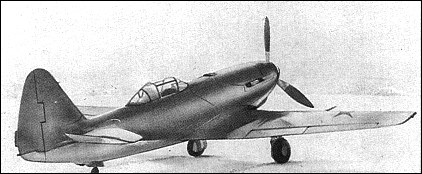|
| Early in 1939, Mikhail M Pashinin, a former deputy of N
N Polikarpov, designed a single-seat fighter reflecting
Spanish and Japanese (Nomonhan Incident) experience
as part of the high priority programme to produce
a successor to the I-16. Assigned the designation
I-21 (despite its earlier use for the Ilyushin-designed
TsKB-32), the fighter was of mixed construction, with a
plywood-covered metal wing, a welded steel tube forward
fuselage and a wooden monocoque rear fuselage. Intended to take the Klimov-developed M-107 engine,
the prototypes were fitted with the Klimov M-105P of
1,050hp because of the non-availability of the more
powerful unit. Armament comprised an engine-mounted
23mm cannon and two wing-mounted
7.62mm machine guns. The first prototype was flown
on 18 May 1940. State Trials, which commenced on 6
June, revealing poor stability. The second prototype
was therefore fitted with revised outer wing panels
with tapered leading and trailing edges. This prototype
attained speeds of 488km/h at sea level and
573km/h at 5000m. As handling
qualities still left much to be desired, a third prototype,
flown in January 1941, embodied considerable wing redesign.
The outer panels were sweptback and clipped,
reducing span by 1.57m, and the tailplane
was modified. Landing characteristics remained poor,
the I-21 demanding an unacceptably long runway, and
a pre-series of five aircraft was discontinued.
 | A three-view drawing (1673 x 1203) |
| MODEL | I-21 (3rd prototype) |
| DIMENSIONS |
| Wingspan | 9.43 m | 31 ft 11 in |
| Length | 8.73 m | 29 ft 8 in |
| PERFORMANCE |
| Max. speed | 580 km/h | 360 mph |
|
Do you have any comments?
|
| 
All the World's Rotorcraft |






